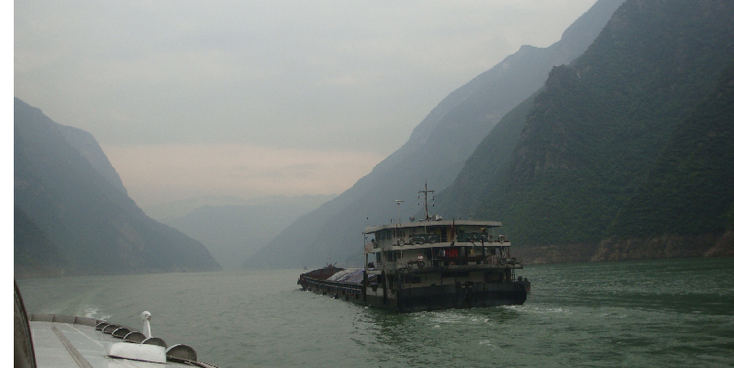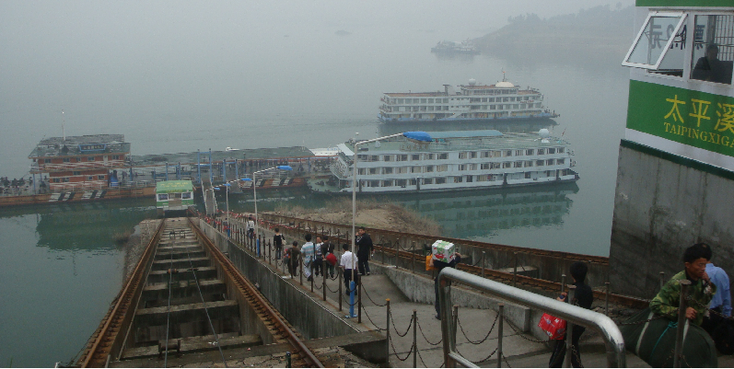Yangtse River
Travel Stories - China

introduction
It is obviously still very dark outside when I am standing downstairs in the hotel lobby in the city Yichang and see that the desk clerk and the two guards are sleeping. On the street it is dead quiet, but when I arrive at the bus station there is quite a crowd of people up and running. Before I arrive at the counter, the girl starts laughing sheepishly as she knows I do not speak Chinese and she does not speak English.
Yet I try again to make it clear to her that I want to go to the boat terminal with the fast boats to "Wanzhou". Meanwhile a whole group of Chinese people have gathered around me looking at me, my backpacks and my book in which everything apparently says what "he" asks. I try everything and in the end – when i write it down – i get a blanco ticket and i hope I got what I asked for.
The boat terminal

The bus stops after 10 minutes for an office where a small food stall stands. I know what I have to do and I get out of the bus to order food. The time you get for a meal is very short and the food is usually hot and very spicy even though the Chinese seem to have little trouble with it.
The smoke comes out of my ears and teardrops come out of my eyes and I'm offered handkerchiefs from different sides. Back in the bus and I see the Yangtze river looming - wide, dark, foggy and crowded - and we are taken to the plateau by a cable cart from the bus-stop. The boat looks like a big hovercraft and I’m sitting down in a seat by the window, which unfortunately consists of plexiglass and is rather blurry.
I read in my travel guide that the start of this 7-hour boat trip is not really exciting and I decide to catch up some sleep. The TV’s are roaring and most Chinese people are more interested in what it has to offer than the mysterious cliffs that pass by outside. Between the two rooms with seats is a kind of hall where the engine is situated and it’s possible to look directly to the cliffs outside. You stand here sheltered from the wind, and since I'm tall enough to look over the motor, you’ve got a beautiful view of the banks and the river that has been used for transport for years.

Yangtze river:
The Yangtze is the third largest river in the world and starts in Tibet to exit in the Chinese sea at Shanghai. In addition to the steep flanks on either side, the low-hanging fog gives it an idyllic magical atmosphere. In May 2006 the controversial Three Gorges Dam was established after fierce demonstrations.
Wuhan and the surrounding area have been frequently hit by devastating floods of the Yangtze and the river Han in the past. One of the reasons to build the Three Gorges Dam in the upper reaches of the Yangtze was to prevent flooding in cities in the lower reaches of the river like Wuhan, Nanjing and Shanghai and to make shipping on the Yangtze easier.
Although there were plans to build the dam since 1919, the construction of the dam was finally started in 1994. On July 4, 2012, the dam became fully operational. It was the largest engineering project since the Great Wall and is in the books as the largest in the world. The river will move 550 km, an area as large as Singapore floods and if he breaks through (he can endure an earthquake 8 on the Richter scale on paper), about half a million will drown within an hour. The existence of the river dolphin and the sturgeon was further endangered by the construction.

We approach the Wu gap which is and feels mysterious. Patches of mist pass by the high green cliffs that look more like walls and occasionally represent small gray concrete houses.
Every now and then we sail big ships that transport coal or a load of new cars. The weather helps the depressive atmosphere that hangs here, and there is no fish, bird or other animal to be detected.
Perhaps the cause of the construction of the three gorges valley dam that lies further. If we get closer to this gap, it becomes busier with tourist boats and the cliffs become steeper and the river narrows. I am pleased that I booked a boat that, in addition to seeing this "tourist" attraction, also simply sailed to the place where I needed to continue my journey. The sloping hills are now built on some arable land and we sometimes see a small "sampan" fishing boat glide past in the dark water of the river. We stop for a while to let some people in and out.

Arrival Wanzhou
When we arrive at Wanzhou in the afternoon a big bus is waiting to take us to the city of Chongqing. On the way some vendors come in the bus and I buy a bag of peanuts; the changy is literally throw back into my lap. The woman next to me has bought a (brown) egg and the peel of it ends up in the corner on the floor. The chair on the other side of the aisle that is still empty is used as a "smoke chair".
The weather is wet but maybe this is "normal" here in panda-country. it’s damp, warm, cloudy and misty. Through the window I see a number of saleswomen with baskets of fruit sitting on the railing of this modern four-lane road and I ask myself if these people are so content with the rapid progress of the country.

CHONGQING:
The residents of the city Chongqing are proud of their resistance to the advance of the Mongolian Empire in the 12th century. They regard their city as the salvation of Europe. Without the resistance, Genghis Khan would probably also have conquered all of Europe. Earlier attempts had been made to make Chongqing an important Western trading post on the Yangtze river but that failed.
The city became famous and known at a stroke when it was established as a war capital (1938-1945) of the Kuomintangs during WWII since Nanking was conquered by the Japanese. The city was heavily bombarded to put the government under pressure but was protected by natural impregnable borders.
Until today, you can discover and view shelters from that period. It was here that in vain the two parties (the other were the Communists) were tried to bind so that a front would arise against the Japanese who already conquered large parts of the country. This failed miserably given the mistrust between the two and Chiang Kaishek's (leader of the Kuomintang's) obsession to exterminate the Communists. Even if this was at the expense of Chinese soil with respect to the Japanese.
In 1943 an agreement was signed between the Kuomintang's and the Americans who were baptized SACO. The intention was for the Americans to train security agents for the Chinese. And although they supported the Russian Communist in their fight against Japan, the Chinese communists could not do any good and many ended up in SACO prisons (and according to the communists many were murdered). After the war, Chongqing became a city again under the management of Sichuan Province. The city was given a new status with the aim to develop the west of China better and to house people who had lost their homes through the Three Gorges Dam project.
After three hours of bussing we stop at the bus station in Chongqing where my intended hostel should be nearby. I walk around, ask people and don’t find anything After several attempts where people try to help me, I come to the conclusion that this was not the main busstation where I thought I was but a local one. So that’s why nobody could help me because probably I’m far away from it.
Hours later I arrive at the gigantic modern bus station surrounded by even higher and larger residential towers. A policeman who wants to raise his status takes me to one of these towers and suddenly I get a lift that takes me to the fourth floor where there is a reception desk. It’s not my hostel where I was planned ot go but it is indeed a hostel and I am assigned an almost clinical room with a shower and toilet located in the corner behind glass. I pay 70 Yuan but have no idea where I am, but I think it's all fine.
At the busstation I am checked thoroughly again and I quickly go into a "fast food" restaurant and eat something because I’m very hungry after my long search. Back in my room I crash down on my bed – it was a long long day.

tips & advice (2009)

Wuhan's international airport "TIanhe" is located 30 km northwest of the city. There are a number of "long-distance" bus stations in the city The most important one (for you as a tourist) is probably "Hankou" which lies to the west of the Yangtze river. In Yichang, the train and bus stations are close together.
Wuhan - Yichang: there are several buses a day to Yichang (where you can take the boat over the "Yangtse" river) from Wuhan. You do about four hours about this trip and the price is around 115Y.
Yichang - Wanzhou (Yangtse River - BOAT): at least one boat departs at 07:15 am this arrives in Wanzhou around 13:15; cost 300 Yuan for a single ticket per person. There should be a "free" bus transfer from the bus station to the Yichang boat terminal.
Wanzhou - Chongqing: there is a bus waiting when the boat arrives at the terminal - it leaves around 13:30 and takes three hours.
Chongqing international airport Jiangbei is located 25 km north of the city center. The bus and train station are almost next to each other to the west of the center.
Chongqing - Leshan: every hour there is a bus from Chongqing to Leshan from 07:00 until about 18:00. Duration is around 2.5 hours and costs 80 Y.

-
Name: View Hotel (Yichang)
Price: 140 Y (single)
Content:
As good as next to the bus station in Yichang (where you get a "free" transfer to the boat terminal in the morning) is a great hotel that is still reasonably affordable.

see also:
LANDEN:
EUROPA:
Albanië * België * Bosnië-Herzegovina * Bulgarije * Denemarken * Duitsland * Engeland * Estland * Finland * Frankrijk * Griekenland * Hongarije * (Noord) Ierland * Italië * Kosovo * Kroatië * Letland * Litouwen * Luxemburg * Macedonië * Malta * Montenegro * NEDERLAND * Oekraïne * Oostenrijk * Polen * Portugal * Roemenië * Rusland * Schotland * Servië * Slovenië * Slowakije * Spanje * Tsjechië * Turkije * Zweden
NOORD EN CENTRAAL-AMERIKA:
Chili * Costa Rica * Cuba * Guatemala * Mexico * Nicaragua * Panama * Verenigde Staten
ZUID-AMERIKA:
Argentinië * Bolivia * Brazilië * Colombia * Ecuador * Peru
AFRIKA:
Botswana * Burkina Faso * Egypte * Ethiopië * Ghana * Kenia * Mali * Marokko * Namibië * Oeganda * Senegal * Tanzania * Tunesië * Zuid-Afrika
MIDDEN-OOSTEN:
Iran * Israël * Jordanië * V.A.E.
AZIE:
Armenië * Cambodja * China * Filipijnen * Georgië * India * Indonesië * Japan * Kirgizië * Laos * Maleisië * Mongolië * Myanmar * Nepal * Oezbekistan * Singapore * Sri Lanka * Thailand * Vietnam
OCEANIE:
Voor meer reisfoto's kijk op www.instagram.com/cheapskatetravel.nl:
© Cheapskatetravel.nl; 2018 (all rights reserved)


